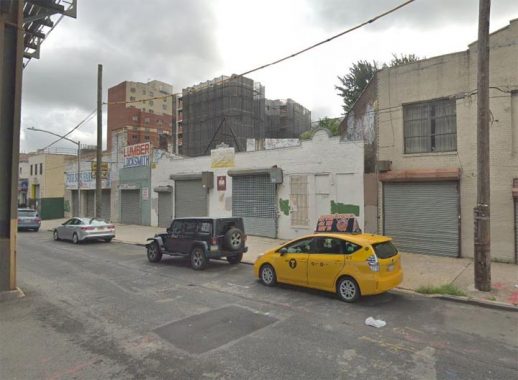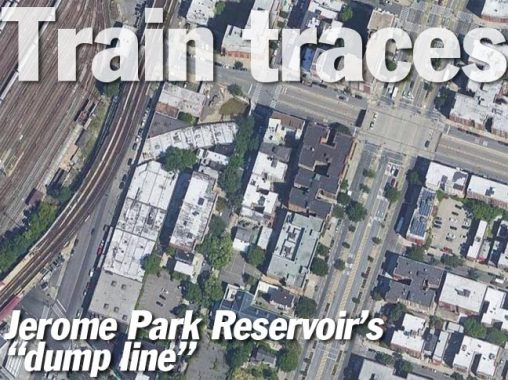by SERGEY KADINSKY
Forgotten NY correspondent
Kevin Walsh has been to the Bronx neighborhood of Bedford Park in 2008, but his observations were limited to the sidewalk. With historical maps and aerial surveys as our guide, one parcel on Jerome Avenue stands out. Block 3321, Lot 25, or 3030 Jerome Avenue.

From the sidewalk viewpoint it appears as a nondescript garage-turned-church in a row of other automotive businesses and storefront churches in the shadow of the elevated Woodlawn Line. But look up at its neighbor’s wall. It does not line up perpendicular to the sidewalk. Its skew to the grid suggests a property line that predates urbanization.

From an aerial survey we see the garage curving across a block of otherwise rectilinear properties in a neighborhood that generally conforms to the street grid. Could it be covering a decommissioned road or railroad?

The 1921 G. W. Bromley atlas plate for Bedford Park shows the area as lightly developed with wooden single-family homes and a couple apartment buildings on Villa Avenue. The curved property has not yet been developed. Notice how it nearly touches the elevated Jerome Avenue Line, but they’re not related to each other.
An atlas page from 1893 depicting a couple of blocks to the east reveals the answer. Between 1866 and 1894 the site of Jerome Park Reservoir was a thoroughbred racecourse. A spur of the New York Central Railroad branched off the Harlem Line near the Botanical Garden, running for a mile to the racecourse’s dedicated station. The arrangement resembles the Meadowlands and Belmont Park spurs that are in use only during sporting events. Notice how Mosholu Parkway was mapped as a parkway but not yet laid out. For now, Schuil Brook is seen flowing on the future roadway. Grand Concourse has not been laid out yet, with Anthony Avenue as its precursor in this neighborhood. With the closing of the racetrack the line was abandoned and unfortunately no photos exist of it in operation except…
With the transformation of the former racecourse into a reservoir, earth had to be carved out on this hilltop, transforming it into a massive crater. Railroad cars were used to take the earth out of the site, as seen in this 1901 photo from Scientific American Magazine. According to the author, trains departed from Jerome Park, likely using this old right-of-way, and then merging with the Harlem Line with some of dirt dumped in Bronx Park. The wagons then branched off on a temporary track on Pelham Parkway running to the wetlands along Westchester Creek, where the soil and rocks were used for land reclamation.
A visit to the garage inspired me to walk on and on the same block is an Art Deco IND substation serving a non-revenue spur of the Concourse Line that takes trains to the Concourse Yard. Gary Fonville documented all the active and former IND substations back in 2012. Built during the Great Depression, IND stations were minimal in design with endless bathroom tiles on their station walls. But the substations are works of art worthy of landmarking.
The substation makes for an ideal visual end to East 204th Street, the northernmost road to have an underpass beneath Grand Concourse. Because this street is only a third of a mile in length, it has the least traffic among the nearly dozen underpasses of the Concourse.
The Bronx is full of curved apartment buildings, especially in hilly neighborhoods where streets must follow topographic contours. 181 St. George’s Crescent is nearly a quarter of a circle, perhaps the most rounded low-rise building in the Bronx. The roundest one of all are the nearby Tracy Towers which are the tallest buildings in this borough. I’m not sure why this crescent is named after England’s patron saint. Perhaps it relates to a church, or the favorite saint of a landowner or developer.
Plenty of ink has been spilled about the Art Deco grandeur of apartment buildings on Grand Concourse, but not as much about neighboring streets and avenues which have their own examples to share. At 185 St. George’s Crescent, the main entrance appears as an oversized futuristic kiosk.
Another fascinating aspect of this crescent is its revolutionary past, as seen on the 1887 map by Thomas Henry Edsall. Among the forts set up by the patriots to stop Gen. William Howe’s redcoats, Negro Fort is the one with the least documentation. British attempts to woo enslaved Africans to the loyalist cause in exchange for freedom are well-known but there were also many blacks who fought for the revolution in exchange for personal freedom. Was this fort manned by black rebels or black loyalists?
The few sources available seem to hint at both sides, depending on who controlled the fort. But it was written that they originated in Virginia, where Lord Dunmore issued a proclamation to slaves offering them freedom in exchange for loyalty. Most did not survive the war, and after it ended they fled to Nova Scotia, and then to Sierra Leone. No trace of Negro Fort remains.
More from Sergey Kadinsky
Gunhill Road, Williamsbridge
Melrose Commons
The Montauk Cutoff
Sergey Kadinsky is the author of Hidden Waters of New York City: A History and Guide to 101 Forgotten Lakes, Ponds, Creeks, and Streams in the Five Boroughs (2016, Countryman Press) and the webmaster of Hidden Waters Blog.
Check out the ForgottenBook, take a look at the gift shop, and as always, “comment…as you see fit.”
12/9/19
